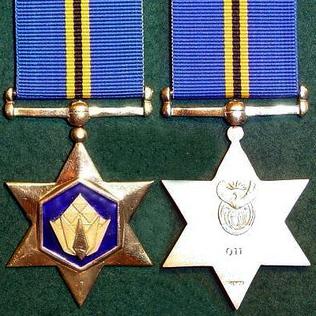
The iPhrothiya yeGolide - Golden Protea, post-nominal letters PG, was instituted by the President of the Republic of South Africa on 16 April 2003 and came into effect on 27 April 2003. It can be awarded to all ranks who have distinguished themselves by exceptional leadership or exceptional meritorious service and the utmost devotion to duty. It is South Africa's highest existing military decoration for meritorious conduct.

The Honoris Crux of 1952, post-nominal letters HC, is a military decoration for bravery which was instituted by the Union of South Africa in 1952. It was in use from 1952 to 1975 and was awarded to members of the South African Defence Force for gallantry in action against the enemy in the field. It was discontinued on 1 July 1975, when it was replaced by a new set of four Honoris Crux decorations, in four classes.

The Louw Wepener Decoration, post-nominal letters LWD, is a military decoration for bravery which was instituted by the Union of South Africa in 1952. It was awarded to members of the South African Defence Force for acts of the most conspicuous courage or greatest heroism. The decoration was discontinued on 1 July 1975, when a new set of decorations and medals was instituted.
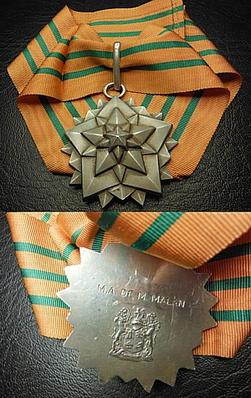
The Star of South Africa, post-nominal letters SSA, is a military decoration for merit which was instituted by the Union of South Africa from 1952 to 1975. It was awarded to general and flag officers of the South African Defence Force for exceptionally meritorious service. The Star of South Africa was discontinued on 1 July 1975, when a new set of orders, decorations and medals was instituted.
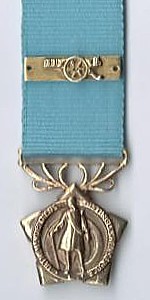
The Van Riebeeck Decoration, post-nominal letters DVR, is a South African military decoration for bravery which was instituted by the Union of South Africa in 1952. It was awarded to officers for distinguished service in the field.

The Van Riebeeck Medal, post-nominal letters VRM, is a military decoration for bravery which was instituted by the Union of South Africa in 1952. It was awarded to other ranks for distinguished service in the field.
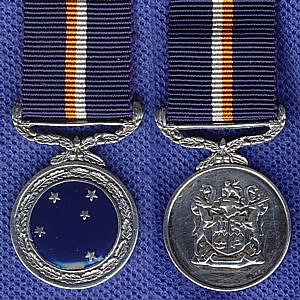
The Southern Cross Medal of 1952, post-nominal letters SM, is a South African military decoration which was instituted by the Union of South Africa in 1952. It was awarded for outstanding devotion to duty and was originally available to all ranks, but from 1967 until July 1975, when it was discontinued, it was reserved for officers.

The John Chard Decoration, post-nominal letters JCD, was a military long service decoration which was instituted by the Union of South Africa on 6 April 1952. It was awarded to members of the Citizen Force of the South African Defence Force for twenty years of efficient service and good conduct. Clasps could be awarded after thirty and forty years service respectively.

The Military Merit Medal, post-nominal letters MMM, is a military decoration which was instituted in the Republic of South Africa on 9 October 1974 as the Chief of the Defence Force's Commendation Medal. It could be awarded to all ranks of the South African Defence Force for service of a high order.

The Pro Merito Decoration, post-nominal letters PMD, is a military decoration for merit which was instituted by the Republic of South Africa on 1 July 1975. It was awarded to other ranks of the South African Defence Force for outstanding service of the highest order and utmost devotion to duty.

The John Chard Medal is a military long service medal which was instituted by the Union of South Africa on 6 April 1952. Until 1986, it was awarded to members of the Citizen Force of the South African Defence Force for twelve years of efficient service and good conduct. The period of qualifying service was reduced to ten years in 1986.

The Pro Virtute Decoration, post-nominal letters PVD, is a military decoration for bravery which was instituted by the Republic of South Africa in 1987. It was awarded to officers of the South African Defence Force for distinguished conduct and exceptional leadership during combat operations in the field.

The Pro Merito Medal of 1975, post-nominal letters PMM, is a military decoration which was instituted by the Republic of South Africa on 1 July 1975. It was awarded to other ranks of the South African Defence Force for exceptionally meritorious service and particular devotion to duty, and was the non-commissioned officers' version of the Southern Cross Medal of 1975 (SM).

The Union Medal was instituted by the Union of South Africa in 1952. It was awarded to Permanent Force members of the South African Defence Force for eighteen years of service and good conduct.

The Distinguished Gallantry Medal was instituted by the State President of the Republic of Bophuthatswana in 1982, for award to all ranks for extraordinary gallantry.
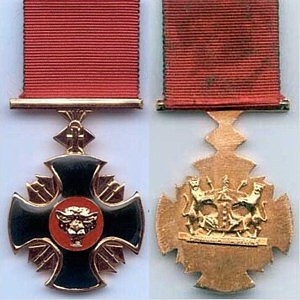
The Distinguished Gallantry Cross was instituted by the State President of the Republic of Bophuthatswana in 1982, for award to all ranks for hair-raising deeds of distinguished heroism.
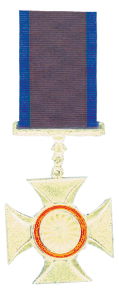
The Gallantry Cross, Gold was instituted by the President of the Republic of Venda in 1985, for award to all ranks for extreme courage or supreme bravery or valour beyond the normal call of duty.

The Gallantry Cross, Silver, post-nominal letters GCS, was instituted by the President of the Republic of Venda in 1985, for award to all ranks for courage or bravery or valour beyond the normal call of duty.

The Sandile Decoration, post-nominal letters SD, was instituted by the President of the Republic of Ciskei in 1988, for award to all ranks for meritorious service.

The Gold Decoration for Merit, post-nominal letters GDM, was instituted by the President of the Republic of South Africa in April 1996. It was awarded to veteran cadres of the Azanian People's Liberation Army, the military wing of the Pan Africanist Congress, for outstanding service and utmost devotion to duty during the "struggle".




















